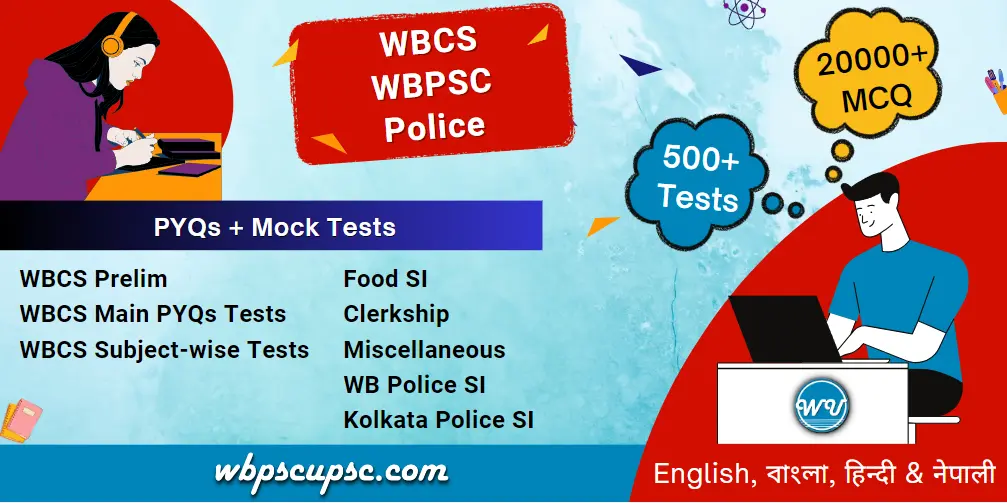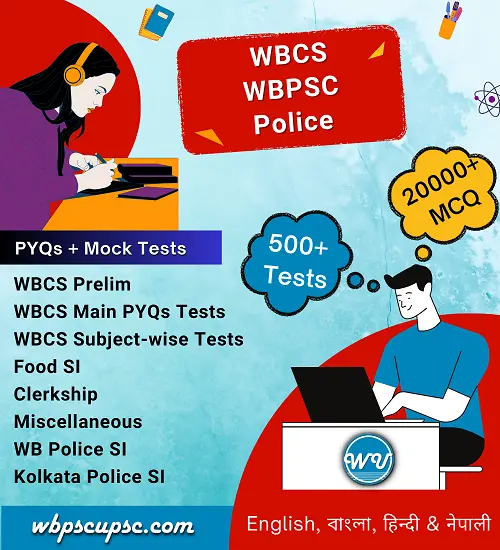61. Which of the following reproductions is found in plants alone?
(A) contraction of eyeball.
(C) dryness of optic nerve.
113. One of the following terms includes rest of the lot. Identify that single term:
WBCS Preliminary Question – 2019
(A) 12 pairs
(B) 31 pairs
(C) 31
(D) 12
(Fat – 9 cal/gram)
(A) protein
(B) carbohydrates
(C) fat
(D) water
(A) rate of heart beats
(B) potential difference
(C) ventricular concentration
(D) volume of blood pumped
(A) Carbon monoxide, Methane and Hydrogen
(B) Carbon dioxide, Methane and Hydrogen
(C) Carbon monoxide, Ethane and Hydrogen
(D) Carbon dioxide, Ethane and Hydrogen
(A) has to detoxify the alcohol.
(B) stores excess of glycogen.
(C) is over stimulated to secrete more bile.
(D) accumulates excess of fats.
WBCS Preliminary Question – 2018
(Sept 1983, Salkani, Karnataka )
(a) Sarala Ben of Ahmedabad
(b) Mira Ben of Rajkot
(c) Pandu Rao Hegde of Sirsi
(d) Sundarlal Bahuguna of Kasauni
(a) 60
(b) 120
(c) 180
(d) 240
(C3H6O3)
(a) Carbon Dioxide
(b) Creatinine
(c) Lactic acid
(d) Ethyl alcohol
(a) 28
(b) 29
(c) 20
(d) 12
94.
Amounts of O2 normally carried by 100 ml of pure human blood, is
(a) 40 ml
(b) 10 ml
(c) 20 ml
(d) 30 ml
(a) Integuments
(b) Gills
(c) Lungs
(d) Trachea
(a) night blindness
(b) rickets
(c) scurvy
(d) hair fall
WBCS Preliminary Question – 2017
(A) floating organisms in water
(B) swimming organisms in water
(C) animals associated with aquatic plants
(D) sub-merged plants in water
(A) Klinefelter syndrome individual
(B) Tripple X syndrome individual
(C) Turner syndrome individual
(D) Sub-human mammalian female individual
(monotreme)
(A) Talpa
(B) Echinda
(C) Pteropus
(D) Lemur
(1983 by Reinhardt Kristensen)
(A) Pogonophora
(B) Kinnorhyncha
(C) Loricifera
(D) Ctenophora
(Tuber)
(A) Carrot
(B) Potato
(C) Groundnut
(D) Turnip
(A) Leptotene
(B) Anaphase -I
(C) Pachytene
(D) Diakinesis
(A) Charles Darwin
(B) Gregor Johann Mendel
(C) Herman Muller
(D) T. H. Morgan
(A) A virus
(B) A bacterium growing in artificial nutrient medium
(C) A fungus causing disease
(D) A phagocytic protozoa
(A) Protostele
(B) Siphonostele
(C) Dictyostele
(D) Atactostele
(A) Glycolysis
(B) Fermentation
(C) Citric Acid Cycle
(D) Electron transport
(1929, Alexander Fleming)
(A) Algae
(B) Fungi
(C) Lichen
(D) Angiosperm
(Pitamber Committee)
(A) 1972
(B) 1980
(C) 1985
(D) 1990
WBCS Preliminary Question – 2016
122. A pure red flower bearing plant is crossed with a pure white flower and the F1 plant bears pink flowers. This is an example of : (1860s, Gregor Johann Mendel)
(A) Pseudo dominance
(B) Dominance
(C) Epistasis
(D) Co-dominance
125. A short day plant has a critical day length of 14 hours. It will flower when the day length is : (Photoperiodism)
(A) 15 hours
(B) 18 hours
(C) 12 hours
(D) 16 hours
(A) Agaricus
(B) Morchella
(C) Synchytrium
(D) Polyporus
(A) Mawaceae
(B) Solanaceae
(C) Labiatae
(D) Orchidaceae
(charophyte green algae)
(A) Oedogonium
(B) Rhizopus
(C) Calamites
(D) Chara
(A) Flagellin
(B) Tubulin
(C) Cellulose
(D) Chitin
(A) Epithelial tissue
(B) Connective tissue
(C) Muscular tissue
(D) Nerve tissue
(Skeletal muscle)
(A) Striated voluntary
(B) Striated involuntary
(C) Non-striated voluntary
(D) Non-striated involuntary
(A) Insects
(B) Crustacea
(C) Beetle
(D) Sponges
(Gause’s law)
(A) Biome
(B) Habitat
(C) Territory
(D) Niche
(liver)
(A) Red Blood Cell
(B) Kidney tissues
(C) Small intestinal tissues
(D) None of the above
WBCS Preliminary Question – 2015
(A) Allogamy
(B) Geitenogamy
(C) Xenogamy
(D) Autogamy
(A) Adenine and Guanine
(B) Thymine and Adenine
(C) Cytosine and Guanine
(D) Thymine and Cytosine
(Indole-3-acetic acid)
(A) NAA
(B) IAA
(C) 2, 4-D
(D) IBA
(A) Interphase
(B) Anaphase
(C) Prophase
(D) Telophase
135. In monohybrid cross of Mendel, when a pure tall plant was crossed with a dwarf plant, all the F1 progeny were tall, because of: (A) Co-dominance
(B) Dominance
(C) Incomplete dominance
(D) Epistasis
(A) Plasmodium vivax
(B) Plasmodium malariae
(C) Plasmodium falciparum
(D) None of the above
(A) G. J. Mendel
(B) Charles Darwin
(C) T. H. Morgan
(D) None of the above
(A) Fossil Fuels
(B) Cryogenic Fuels
(C) Indigenous Fuels
(D) Radioactive Fuels
(A) Antheraea mylitta
(B) Bombyx mori
(C) Philosomia ricini
(D) Antheraea assamensis
(A) 34A°
(B) 3.4A°
(C) 24A°
(D) 44A°
(A) 9 : 3 : 3 : 1
(B) 1 : 1 : 1 : 1
(C) 3 : 4 : 3 : 1
(D) 1 : 2 : 1 : 1
(A) 10 pairs
(B) 10
(C) 12 pairs
(D) 12
WBCS Preliminary Question – 2014
(A) Prophase
(B) Metaphase
(C) Anaphase
(D) Telophase
(A) Stomach
(B) Intestine (small)
(C) Intestine (large)
(D) Colon
42. Rhizome is a modified stem because (A) it grows vertically upward in the soil and it has fleshy leaves.
(B) it has nodes and it has eyes which bears germinating buds.
(C) its stem is highly condensed and disc like.
(D) it has nodes, internodes and has brown, scaly leaves.
(Neuron)
(A) Nerve cell
(B) Hepatocyte (Liver cell)
(C) Blood cell
(D) Muscle cell
(taproot)
(A) Conical with small roots.
(B) Conical without small roots.
(C) Round with small roots.
(D) Irregular with no small roots.
(edematous malnutrition)
(A) Pellagra
(B) Ricket
(C) Kwashiorkor
(D) Retinoblastoma
(A) Polio
(B) Malaria
(C) Dermatitis
(D) Cholera
(A) Root
(B) Stem
(C) Leaf
(D) Flower bud
(Thalamus)
(A) Date
(B) Plum
(C) Apple
(D) Grape
(human immunodeficiency virus)
(A) Bacteria
(B) Virus
(C) Protozoa
(D) Helminth
(grass-like flowering plants)
(A) Leaf shows reticulate venation
(B) Tap root system
(C) Flowers are trimerous
(D) Perennial growth
WBCS Preliminary Question – 2013
(sexual reproduction)
(A) Embryo
(B) Endosperm
(C) Suspensor
(D) Pericarp
(A) Soil erosion
(B) Pollution
(C) Flood
(D) All of the above
(A) Groundnut
(B) Coconut
(C) Mustard
(D) Sesame
(vertebrae of neck)
(A) Seven
(B) Seventeen
(C) Seventy seven
(D) Eleven
(A) Urodela
(B) Anura
(C) Gymnophiona
(D) None of the above
(A) Warm blood
(B) Four chambered heart
(C) Trachea
(D) Diaphragm
(Respiratory System)
(A) Bronchus
(B) Branchiostegal membrane
(C) Branchiostegite
(D) Branchiostegal spine
(enzyme – starch into sugar)
(A) Brain
(B) Blood
(C) Thyroid
(D) Pancreas
WBCS Preliminary Question – 2012
(Filariasis)
(A) Blood
(B) Lymphatics
(C) Liver
(D) Intestine
(Antidiuretic Hormone)
(A) Diabetes insipidus
(B) Diabetes mellitus
(C) Grave’s disease
(D) Cushing’s disease
(no true marine amphibians)
(A) Mammals
(B) Amphibian
(C) Reptiles
(D) Aves
(pH range 7.35 to 7.45)
(A) Acidic
(B) Alkaline
(C) Neutral
(D) Variable
(A) Viper
(B) Krait
(C) Python
(D) Coral Snake
(A) Trypanosomiasis
(B) Giardiasis
(C) Encephalitis
(D) Oriental sore
(Carl Nageli in 1858)
(A) Photosynthesis of plants
(B) Transport of water and mineral nutrients in plants
(C) Storage of prepared food in plants
(D) Transport of enzymes in plants
(1859)
(A) J. B. S Haldane
(B) G. J. Mendel
(C) A. I. Oparin
(D) C. R Darwin
192. The enzyme ‘DNA gyrase’ is associated with the function of (ATP-dependent type II topoisomerase)
(A) Protein syntheses
(B) DNA replication
(C) Lipid biosynthesis
(D) DNA damage
195. The plant body is not ‘differentiated into root, stem and leaves’ in (A) Pteridophytes
(B) Angiosperms
(C) Gymnosperms
(D) Algae
200. The total mass of all the organisms of a given type and/or in a given area is called (species biomass)
(A) Biome
(B) Biomass
(C) Biomarer
(D) Biosensor
WBCS Preliminary Question – 2011
(Gulf Coastal Plain, USA)
(A) Quercus Incana (Oak Tree)
(B) Eleusine Coracana (finger millet)
(C) Phoenix Paludosa
(D) Kydia Calycina
(aquatic flower)
(A) Ceratophyllum
(B) Eichhornia
(C) Monochoria
(D) Pistia
(1953, Nature magazine)
(A) Life history of Plasmodium Vivax
(B) Vaccinia
(C) Structure of DNA
(D) Antibodies
(A) Ectoderm
(B) Endoderm
(C) Mesoderm
(D) Both endo and mesoderm
(1935, William Cumming Rose)
(A) 10
(B) 20
(C) 30
(D) 40
102. Which of the following is an unlatching group ?
(A) Cray fish, cuttle fish and hag fish
(B) Star fish, sea urchin and sea cucumber
(C) Cockroach, crab and spider
(D) Whale, lizard and frog
(100 micrometre = 0.1 mm)
(A) 1 micron
(B) 10 microns
(C) 100 microns
(D) 1000 microns
(Proteins to peptides)
(A) Insulin
(B) Ptyalin
(C) Pepsin
(D) Trypsin
(chlorophyte green algae)
(A) Chlorella
(B) Trentepohlia
(C) Spirullina
(D) Sargassum
(A) C3 cycle
(B) C4 cycle
(C) C2 cycle
(D) Both C3 and C4 cycle
(polymeric glucose – (C6H10O5)n)
(A) Cellulose
(B) Sucrose
(C) Starch
(D) Lignin
WBCS Preliminary Question – 2010
(A) X-linked recessive
(B) X-linked dominant
(C) Y-linked
(D) Located in autosome
30. The narrow portion between uterus and vagina of higher mammals is known as (A) Clitoris
(B) Urethra
(C) Oviduct
(D) Cervix
(neurological disease)
(A) Uranium
(B) Mercury
(C) Cadmium
(D) Arsenic
(Joint forest management 1971-72)
(A) Forest Guards
(B) Panchayat Members
(C) Forest Villages, Forest Department and Panchayat
(D) Forest Department officials
(A) Sporophyte
(B) Gametophyte
(C) Sporophyte or gametophyte
(D) Sporophyte and gametophyte
36. Enzymes speed up biochemical reactions by (A) Increasing the activation energy of the reaction
(B) Lowering the temperature of the reaction
(C) Increasing the temperature of the reaction
(D) Lowering the activation energy of the reaction
(A) Interconnection of cells by intercalated disc
(B) Having numerous mitochondria
(C) Having more actins
(D) Having more myosin
(A) Cytosol
(B) Grana of Chloroplast
(C) Stroma of chloroplast
(D) Ribosome
(Haversian canals)
(A) Kidney
(B) Bone
(C) Heart
(D) Brain
45. Polytene chromosome is found in the cells of
(Dipteran Flies)
(A) Salivary gland of larvae of flies
(B) Liver of man
(C) Neuron of insects
(D) None of the above
(hidden stomata, hot desert plant)
(A) Hydrophytes
(B) Xerophytes
(C) Halophytes
(D) Mesophytes
(A) Sucrose
(B) Fructose
(C) Cellulose
(D) Glucose (C₆H₁₂O₆)
(A) Sodium
(B) Potassium
(C) Cobalt
(D) Iron
(1953)
(A) H. G. Khorana
(B) Watson and Crick
(C) Frederick Sanger
(D) E. M. Southern
(phylogeny)
(A) Evolutionary relationship
(B) Phenatic relationship
(C) Genetic relationship
(D) Taxonomic relationship
(RNA converted into DNA)
(A) DNA virus
(B) RNA virus
(C) Either DNA or RNA virus
(D) Both DNA and RNA virus
(A) Oxidative phosphorylation
(B) Oxidative decarboxylation of pyruvic acid
(C) Krebs cycle
(D) Glycolysis
(Feb 1991)
(A) Tidal Height
(B) Sea Level Rise
(C) Depth of Water
(D) Undersea Bathymetry
WBCS Preliminary Question – 2009
(actually 60%)
(A) 66
(B) 50
(C) 33
(D) 10
(A) Goitre
(B) Night blindness
(C) Ricket
(D) Rheumatism
(A) Tocopherol
(B) Cyanocobalamin
(C) Ascorbic acid
(D) Thiamine
75. Greenhouse effect is caused by addition of too much of this compound in atmosphere. (A) Carbon di-oxide
(B) Ammonia
(C) Water vapour
(D) Dust particles
(A) Fruit wall
(B) Endosperm
(C) Cotyledon
(D) Embryo
(A) Seed
(B) Leaf
(C) Flower
(D) Bark
(synthetic auxin)
(A) Destroy Crops
(B) Pollute Air
(C) Remove leaves and reveal enemy hiding places
(D) Start forest fire
(A) One hour before rise of temperature
(B) Five hours after temperature
(C) When temperature rise with rigor
(D) Any time
(A) Nicotinic acid
(B) Pyridoxine
(C) Pantothenic acid
(D) Riboflavin
(Arthropod)
(A) Salivary gland
(B) Green gland
(C) Ink gland
(D) Malpighian tubule
(A) Cow
(B) Dog
(C) Pigeon
(D) Cameleon
(Wildlife Protection Act, 1972)
(A) Schedule I
(B) Schedule II
(C) Schedule III
(D) None of the above
(A) Tasar
(B) Munga
(C) Eri
(D) Mulberry silk
(2 Feb 1971)
(A) Earth Sumit
(B) Ramsar Convention
(C) Belem Declaration
(D) Botanical Congress
WBCS Preliminary Question – 2008
102. Amount of
blood pumped by an adult heart per hour is about
(A) 150 litre
(B) 200 litre
(C) 300 litre
(D) 340 litre
(A) DNA
(B) RNA
(C) Both RNA and DNA
(D) None of the above
108. A father feeds his baby, he smiles and babbles encouragingly. The
father’s babbling could be considered
(A) Primary reinforcement
(B) Secondary reinforcement
(C) Classical conditioning
(D) Contiguity learning
(A) Barometer
(B) Sphygmomanometer
(C) Tonometer
(D) None of the above
(A) Energy transformations are multi-directional in nature
(B) Energy is the denominator of all kinds of system
(C) Energy transformations are one way indirection
(D) None of the above
(A) Trauma
(B) Amnesia
(C) Coma
(D) Paramnesia
(A) Vitamin A
(B) Folic acid
(C) Vitamin D
(D) Vitamin K
(A) Plasmodium vivax
(B) Plasmodium falciparum
(C) Plasmodium malarie
(D) Plasmodium ovale
(A) Uracil
(B) Adenine
(C) Thymine
(D) Cytosine
137. Stimulating the
occipital area of the brain produces sensation of
(A) Vision
(B) Taste
(C) Motion
(D) Touch
(A) Photosynthesis
(B) Protein synthesis
(C) Lipid synthesis
(D) Respiration
(A) Ultraviolet
(B) Infrared
(C) Solar
(D) Both (A) and (B)
(A) Longitudinal
(B) Correlational
(C) Naturalistic
(D) Cross-sectional
(A) Gulancha
(B) Nayantara
(C) Basak
(D) Pitcher Plant
(A) Caffeine
(B) Barbiturates (depressant)
(C) Cocaine
(D) Amphetamines
(A) Regulatory genes
(B) Oncogenes
(C) Structural genes
(D) Jumping genes
(A) Cingulate cortex
(B) Substantia nigra
(C) Reticular formation
(D) Cerebral cortex
(A) Neurosis
(B) Depression
(C) Hysteria
(D) Schizophrenia
(A) Bees
(B) Birds
(C) Butterflies
(D) Wind
(A) Recall new information
(B) Remember small details
(C) Learn new information
(D) Use new information
(A) Ethnology
(B) Ecology
(C) Etiology
(D) Environmental factors
(A) Anabolism
(B) Catabolism
(C) Metabolism
(D) None of the above
(A) DNA polymerase
(B) RNA polymerase
(C) Endonuclease
(D) Reverse transcriptase
(John Bowlby’s attachment theory)
(A) Beck-cognitive therapy
(B) Adler-individual therapy
(C) Freud-psychoanalysis
(D) Bowlby-behaviour therapy
(kala-azar parasites)
(A) Sand fly
(B) Tse-tse fly
(C) Dragon fly
(D) Anopheles mosquito
(A) An individual test for adults
(B) An individual test for children
(C) A group test for children
(D) A group test for adults
196. Of the patients with the following diagnosis, which is most likely to voluntarily commence
psychotherapy?
(A) The patient with depressive reaction
(B) The patient with anxiety disorder
(C) The patient with phobia
(D) The patient with personality disorder
(A) Social skills
(B) Language skills
(C) Musical skills
(D) G-factor
WBCS Preliminary Question – 2007
(A) Cytokinin
(B) Auxin
(C) Gibberellin
(D) Ethylene
(A) Hemophilia
(B) Color blindness
(C) Alzheimer’s disease
(D) Down’s syndrome
(A) Biotic component in an ecosystem
(B) Abiotic component in an ecosystem
(C) both (A) and (B) above
(D) None of the above
(A) Infective particle of virus
(B) Infective particle of bacteriophage
(C) Infective stage of virus
(D) None of the above
(A) Carbon di-oxide
(B) Hydrogen fluoride
(C) Carbon monoxide
(D) Sulphur di-oxide
(A) Stalk of flower
(B) Stalk of a leaf
(C) Stalk of a fruit
(D) None of the above
(A) Culex mosquito
(B) Phlebotomus sand-fly
(C) Climex bed-bug
(D) Sarcoptes mite
(A) XY Chromosomes
(B) XO Chromosomes
(C) XX Chromosomes
(D) XXO Chromosomes
(A) Garden lizard
(B) Spider
(C) Gorilla
(D) Ant
138. All
food tins in nature begin at the producer level and all end at the decompose level. Which of die following is be producer in a pond ecosystem?
(A) Phytoplankton
(B) Zooplankton
(C) Herbivores
(D) Carnivores
(A) Tobacco Mosaic virus
(B) Cauliflower Mosaic virus
(C) Adenovirus
(D) None of the above
(A) Co-polymer of carotenoids & fatty acid
(B) Carbohydrate
(C) Protein
(D) Lactic acid
WBCS Preliminary Question – 2006
(a) Sensory cell
(b) Sensory organelles
(c) Protein molecule
(d) Gradient of K
(a) Liver
(b) Urinary Bladder
(c) Kidney
(d) Hemoglobin
(a) IAA
(b) Abscisic acid
(c) Cytokinins
(d) NAA
(a) All eukaryotic cells
(b) Yeast and bacteria only
(c) Bacteria only
(d) All cells
(a) Auxin
(b) Gibberelins
(c) Abscisic acid
(d) Cytokinins
72.
From a cross between a pure strain of plants with yellow peas and pure strain of plants with green peas, how many different eggs are produced by F1 offspring?
(a) 1
(b) 2
(c) 4
(d) 8
(a) Archaeopteryx
(b) Platypus
(c) Java Apeman
(d) Whale
(a) Ultra filtration
(b) Tubular Reabsorption
(c) Tubular Secretion
(d) Phagocytosis
(a) Racemose
(b) Hvpanthodium
(c) Cyathium
(d) Spadix
(a) Cortex
(b) Medulla
(c) Renal Pelvis
(d) Ureter
(a) Cancer
(b) Leukemia
(c) Typhoid
(d) Yellow Fever
(a) Hydra
(b) Euglena
(c) Amoeba
(d) Paramaecium
WBCS Preliminary Question – 2005
(a) Individual
(b) Family
(c) Genus
(d) Species
44. Which one of the following plants keep its stomata open during night and closed during the day?
(a) Water Lily
(b) Cactus
(c) Sun flower
(d) Fern
(a) increase blood pressure
(b) increase urine formation
(c) increase cellular respiration
(d) release epinephrine
63. Which one of the following plant tissues are composed of dead cells?
(a) Xylem
(b) Phloem
(c) Parenchyma
(d) Hypodermis
94. Which one of the following blood-group-bearing persons is called a universal donor?
(a) A
(b) B
(c) AB
(d) O
96. The largest reservoir of Nitrogen on Earth is
(a) Soil
(b) Air
(c) Ocean
(d) Rock
104. According to the cellular structure which one of the following is most complex?
(a) Bacteria
(b) Protozoa
(c) Algae
(d) Fungi
105. Plants store glucose in the form of
(a) Monosaccharide
(b) Cellulose
(c) Starch
(d) Glycogen
107. The amount of blood in the blood circulatory system of a man is
(7% of body weight)
(a) one litre
(b) two litres
(c) five litres
(d) ten litres
114. Of the twenty
amino acids how many are considered essential?
(a) Six
(b) Nine
(c) Twelve
(d) Fourteen
135. Cholesterol is a/an
(a) Saturated fat
(b) Unsaturated fat
(c) Steroid
(d) Diglyceride
136. Which one of the following animals possesses the least number of body segments?
(a) Flatworm
(b) Earthworm
(c) Prawn
(d) Cockroach
137. Sweat, saliva, and tear contain an enzyme called Lysozyme. It kills
(a) Virus infected cells
(b) Protozoa
(c) Bacteria
(d) Virus
162. Antibodies are synthesized by
(a) Bone marrow
(b) Plasma and Lymph
(c) Liver
(d) Kidney
167. The first hormone produced by Genetic Engineering is
(a) Estrogen
(b) Testosterone
(c) Thyroxin
(d) Insulin
196.The scientific name of Vitamin ‘C’ is
(a) Acetic acid
(b) Muriatic acid
(c) Ascorbic acid
(d) Lactic acid
WBCS Preliminary Question – 2003
36. Pitcher plant is
(A) Autotrophic
(B) Heterotrophic
(C) Insectivorous
(D) Actinomorphic
46. AIDS is
(A) Viral disease
(B) Fungal disease
(C) Bacterial disease
(D) Genetically disease
56. Universal donor in blood transfusion refers to
(A) Blood Group A
(B) Blood Group B
(C) Blood Group AB
(D) Blood Group O
66. Scurvy is caused by the deficiency of
(A) Vit. A
(B) Vit. B
(C) Vit. C
(D) Vit. D
76. Which of the following becomes zero in a fully turgid cell?
(A) Water potential
(B) Wall pressure
(C) Osmotic pressure
(D) All of the above
86. Colles’ fracture is associated with
(A) Humerus
(B) Radius
(C) Ulna
(D) Femur
96. Septicemia is
(A) Food poisoning
(B) Blood poisoning
(C) Mental disorder
(D) None of the above
106. Malaria is caused by
(A) Plasmodium
(B) Anopheles mosquito
(C) Cuiex mosquito
(D) Bad air
136. The following animal has a similar vision as we have
(A) Crow
(B) Owl
(C) Horse
(D) Pigeon
156. The genetic information is carried by
(A) Protein
(B) Fatty acids
(C) Nuclear acids
(D) Carbohydrate
186. Which of the following is the hardest substance in the human body?
(A) Bone
(B) Enamel
(C) Dentine
(D) Nail
196. The following animal is called a friend of farmer:
(A) Cow
(B) Earthworm
(C) Rhizobium
(D) Honey-bee
WBCS Preliminary Question – 2002
25. During photosynthesis,
(A) Presence of oxygen is essential
(B) Catabolic reaction takes place
(C) Light energy is stored as potential chemical energy in the food (glucose)
(D) Stored potential chemical energy of food is released as heat energy and other forms of energy.
41. Which one is the connecting link between Reptiles and Mammals?
(A) Peripatus
(B) Lung fish
(C) Duckbill platypus
(D) Archaeoptaryx (Extinct)
72. Fixation of nitrogen is meant
(A) Liquefaction of nitrogen
(B) Conversion of atmospheric nitrogen into a useful compound
(C) Manufacture of nitrogen from the air
(D) Conversion of nitrogen into nitric acid
82. Which one of the following is not an endocrine gland?
(A) Adrenal gland (cortex)
(B) Pituitary gland
(C) Salivary gland
(D) Thyroid gland
26. Identify from the following names the person who is associated with the Chipko movement
(A) BabaAmte
(B) Sunderlal Bahuguna
(C) MedhaPatkar
(D) Arundhuti Roy
104. Normal leaves are called
(A) Seed leaves
(B) Flora leaves
(C) Foliage leaves
(D) Scale leaves
142. The roots of a tree are
(A) Negatively geotropic
(B) Positively geotropic
(C) Positively phototropic
(D) Negatively hydrotropic.
146. Majority of animal viruses contain
(A) DNA
(B) RNA
(C) RNA and DNA
(D) None of DNA
147. In which part of the human body, urea is produced?
(A) Kidneys
(B) Liver
(C) Pancreas
(D) Urinary bladder
159. Which of the following vitamin is most easily destroyed by heat and air?
(A) A
(B) B
(C) C
(D) D
(A) Killing bacteria and germs
(B) Greatly retarding the rates of biochemical reaction
(C) Providing a cover of ice over food
(D) Stopping enzyme action
173. Which of the following is an infectious bacterial disease?
(A) Conjunctivitis
(B) Diphtheria
(C) Influenza
(D) Measles
WBCS Preliminary Question – 2001
42. The image of an object formed on the retina of the eye is
(A) Virtual and erect
(B) real and erect
(C) Virtual and inverted
(D) real and inverted
130. The erosion of soil by winds can be best controlled by
(A) afforestation
(B) removal of vegetation
(C) dry farming
(D) creation of wind breaks
66. Chlorine is not a constituent of
(A) DDT
(B) chlorophyll
(C) chloroform
(D) bleaching powder
(A) it is very rare
(B) it is an important constituent of all proteins
(C) it has a high nutritive value
(D) it is not formed in the body and has to be provided through food
90. _____ is an antivitamin.
(A) beta carotene
(B) methylcobalamin
(C) pyrithiamine
(D) folic acid
101. Which part of ear maintains the balance of our body?
(A) otolith
(B) malleus
(C) tympanic membrane
(D) cochlea
161. Which one of the following is a protozoa?
(A) Pea mosaic
(B) Entamoeba histolytica
(C) Yeast
(D) Yariola
162. The disease is caused by a deficiency of vitamin B12
(A) aplastic anaemia
(B) sickle cell anaemia
(C) normocytic anaemia
(D) pernicious anaemia
163. The National Wildlife Action Plan was adopted by India in
(3rd Plan 2017-31)
(A) 1963
(B) 1973
(C) 1983
(D) 1993
WBCS Preliminary Question – 2000
25. The closest distance at which a normal person can clearly see an object is
(A) 10 cm.
(B) 50 cm.
(C) 80 cm.
(D) 25 cm.
37. Which one of the following is not an autotrophy?
(primary producer)
(A) Grass
(B) Green Algae
(C) Fungus
(D) Fern
38. Photosynthetic plants store glucose as
(A) Sucrose
(B) Starch
(C) Cellulose
(D) Glycogen
40. In the present concept of evolution the unit of evolution is
(A) Individual
(B) Families
(C) Population
(D) Species
41. Which one of the following is a Reptile?
(A) Salamander
(B) Turtle
(C) Newt
(D) Shark
42. Yellowing of plant leaves is called chlorosis, Insufficiency of which ion causes it?
(A) Sodium
(B) Phosphorus
(C) Calcium
(D) Magnesium
43. A red blood cell lives for about
(A) One week
(B) One month
(C) Four months
(D) One year
44. The percentage of solar energy absorbed by the leaves of green plant in photosynthesis is
(A) 1
(B) 10
(C) 30
(D) 50




